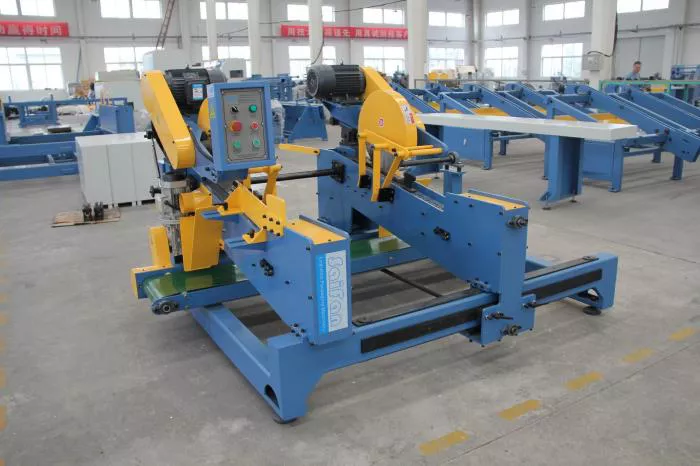Cutoff saws are powerful tools designed for making straight, precise cuts through various materials. These saws typically feature an abrasive disc or toothed blade that rotates at high speeds to slice through workpieces. Originally developed for metalworking applications, cutoff saws have evolved to handle different materials including wood.
The fundamental design of a cutoff saw includes a base, motor, blade guard, and cutting head that pivots to make angled cuts. Most models have a vise or clamping mechanism to secure the workpiece during operation. The cutting action occurs when the spinning blade is lowered onto the stationary material.
Different Types of Cutoff Saws
Several cutoff saw varieties exist, each with specific characteristics. Abrasive chop saws use abrasive discs that grind through material. Cold saws employ toothed blades that cut without generating excessive heat. Metal-cutting chop saws are optimized for ferrous and non-ferrous metals.
Woodworking cutoff saws differ from their metal-cutting counterparts in several ways. They typically use finer-toothed blades designed to cleanly cut through wood fibers without excessive tear-out. The blade speed is often adjustable to accommodate different wood types and thicknesses.
Blade Selection for Wood Cutting
Choosing the proper blade is critical when using a cutoff saw for wood. Carbide-tipped blades with 60 to 80 teeth work well for most woodcutting applications. The tooth geometry should be appropriate for the specific wood type – alternate top bevel (ATB) teeth work well for crosscutting hardwoods.
Blade diameter must match the saw’s specifications, typically ranging from 10 to 14 inches for wood applications. Thin-kerf blades remove less material and require less power but may be less stable for thick stock. Proper blade sharpness is essential – dull blades increase cutting resistance and can burn the wood.
Safety Considerations When Cutting Wood
Operating a cutoff saw requires strict adherence to safety protocols. Always wear personal protective equipment including safety glasses, hearing protection, and dust masks. Keep hands clear of the cutting path and use push sticks for small workpieces.
The work area should be clean and well-lit with adequate ventilation. Ensure the blade guard functions properly and retracts smoothly. Never reach under the guard while the blade is spinning. Allow the blade to reach full speed before beginning the cut and let it stop completely before raising it.
Proper Setup for Woodcutting
Correct machine setup significantly impacts cutting performance. Secure the saw on a stable, level surface. Verify the blade is installed with teeth pointing in the proper rotation direction. Adjust the vise or clamping system to firmly hold the workpiece without crushing it.
Set the cutting depth to slightly exceed the material thickness – typically 1/4 inch beyond the workpiece. For angled cuts, verify the bevel scale accuracy with a square. Check that the blade path clears all clamps and fixtures before starting the saw.
Cutting Techniques for Optimal Results
Effective cutting technique produces cleaner cuts and extends blade life. Begin by marking cut lines clearly on the workpiece. Position the material securely against the fence or guide. Start the saw and allow the blade to reach full speed before initiating the cut.
Apply steady, even pressure when lowering the blade into the wood. Avoid forcing the cut – let the blade teeth do the work. For thick stock, consider making multiple shallow passes rather than one deep cut. When completing the cut, maintain pressure until the blade fully exits the material.
Maintaining Your Cutoff Saw
Regular maintenance ensures consistent performance and safety. Clean sawdust and debris from the saw after each use. Periodically check and tighten all fasteners. Lubricate moving parts according to the manufacturer’s recommendations.
Inspect blades for missing or damaged teeth and replace as needed. Check electrical cords for damage and keep them away from the cutting area. Store the saw in a dry location and cover it when not in use to prevent dust accumulation.
Comparing Cutoff Saws to Other Woodcutting Tools
While cutoff saws can cut wood effectively, other tools may be better suited for certain applications. Miter saws offer greater precision for angled cuts in trim work. Table saws excel at rip cuts and sheet goods. Circular saws provide portability for job site use.
Cutoff saws shine when making repeated straight cuts in dimensional lumber or when metal and wood cutting are both required. Their robust construction handles heavy-duty cutting tasks that might overwhelm lighter woodworking saws.
Potential Limitations and Workarounds
Cutoff saws present some limitations when cutting wood. The fixed cutting path restricts maneuverability compared to handheld saws. Dust collection may be less effective than dedicated woodworking tools. Vibration can affect cut quality in some materials.
Solutions include using zero-clearance inserts to reduce tear-out, installing wood-specific blades, and adding auxiliary dust collection ports. For fine woodworking, follow up cutoff saw cuts with hand planes or sanding to achieve finished edges.
Applications Where Cutoff Saws Excel with Wood
Certain woodcutting tasks are particularly well-suited to cutoff saws. Framing and rough carpentry benefit from the saw’s power and speed. Cutting treated lumber is easier with a cutoff saw’s robust construction. Demolition work involving embedded nails won’t damage wood-specific blades.
Production environments appreciate the repeatability of cutoff saw cuts. The ability to quickly process large quantities of dimensional lumber makes these saws valuable for deck building, fencing projects, and similar high-volume applications.
Conclusion
Cutoff saws can effectively cut wood when properly configured with the right blade and technique. While not as specialized as dedicated woodworking saws, they offer versatility for shops that work with multiple materials. Understanding the tool’s capabilities and limitations allows woodworkers to safely incorporate cutoff saws into their workflow. With proper setup and operation, these powerful tools produce clean, accurate cuts in various wood types and applications.
Relate topics:
- What Sizes Do Circular Saws Come In
- 5 Best Stihl Chainsaw Models: A Complete Guide
- 5 Top Best Chainsaws: A Comprehensive Guide

